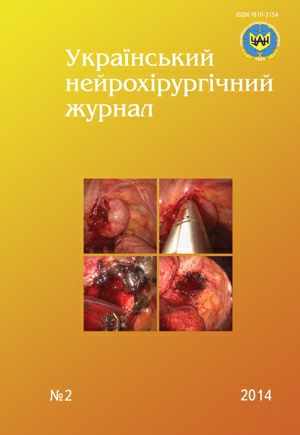Surgical tactics and treatment results at spinal lymphomas
DOI:
https://doi.org/10.25305/unj.51298Keywords:
non-Hodgkin’s lymphomas, Hodgkin’s lymphomas, spinal cord, surgical treatmentAbstract
The purpose — to study features of lymphomas affecting spinal cord and it’s membranes, to develop rational tactics for their treatment.
Material and methods. 9 patients with spinal lymphomas were examined. All patients have been operated, the diagnosis was verified histologically. Preoperative diagnostics was based on clinical data and neurological examination, X-ray, MRI. Electroneuromyography was performed in 5 patients, bone scintigraphy — in 3.
Results. Two main localization of lymphomas were identified: I — intramedullar lesion, and II — lesion of dura mater of the spinal cord with epidural, subdural or epi-subdural spread. In 3 cases intramedullar lesion was revealed, in 6 — lesion of dura mater of the spinal cord.
Conclusions. There are tumors that primary affects the spinal cord or it’s dura mater. Tumors affecting the spinal cord, non-Hodgkin’s lymphomas as a rule are the primary. Tumors affecting spinal dura mater are Hodgkin’s lymphoma, and usually are the secondary, they manifested after prolonged conservative treatment. The histological diagnosis of lymphoma should be confirmed by immunohistochemical studies. Tactics of treatment at spinal lymphomas with neurological manifestations should be directed to their removal, decompression of spinal cord followed by radiotherapy, chemotherapy and corticosteroid therapy if necessary.
References
1. Flanagan E, O’Neill B, Habermann T, Porter A, Keegan B. Secondary intramedullary spinal cord non-Hodgkin’s lymphoma. J. Neurooncol. 2012;107(3):575–580. [CrossRef]
2. Flanagan E, O’Neill B, Porter A, Lanzino G, Haberman T, Keegan B. Primary intramedullary spinal cord lymphoma. Neurology. 2011;77(8):784–791. [CrossRef]
3. Grimm S, Chamberlain M. Hodgkin’s lymphoma: a review of neurologic complications. Adv Hematol. 2011;2011:624578. [CrossRef]
4. Kumar N, Keegan B, Rodriguez F, Hammack J, Kantarci O. Intravascular lymphoma presenting as a longitudinally-extensive myelitis: Diagnostic challenges and etiologic clues. J. Neurol. Sci. 2011;303(1–2):146–149. [CrossRef]
5. Lin YY, Lin CJ, Ho DM, Guo WY, Chang CY. Primary intramedullary spinal cord lymphoma. Spine J. — 2012;12(6):527–528. [CrossRef]
6. Machiya T, Yoshita M, Iwasa K, Yamada M. Primary spinal intramedullary lymphoma mimicking ependymoma. Neurology. 2007;68(11):872. [PubMed]
7. Mechtler LL, Nandigam K. Spinal cord tumors: new views and future directions. Neurol. Clin. 2013;31(1):241–268. [CrossRef]
8. Sekiguchi Y, Matsuzawa N, Shimada A, Imai H, Wakabayashi M, Sugimoto K, Nakamura N, Sawada T, Izutsu K, Takeuchi K, Ohta Y, Komatsu N, Noguchi M. Angioimmunoblastic T-cell lymphoma with intramedullary production of platelet-derived growth factor and possibly complicating myelofibrosis: Report of a case with review of the literature. Int. J. Hematol. 2013;98(2):250–257. [CrossRef]
Downloads
Published
How to Cite
Issue
Section
License
Copyright (c) 2014 Eugene Slynko, Anatoliy Pastushin, Tatyana Malysheva, Oksana Chernenko

This work is licensed under a Creative Commons Attribution 4.0 International License.
Ukrainian Neurosurgical Journal abides by the CREATIVE COMMONS copyright rights and permissions for open access journals.
Authors, who are published in this Journal, agree to the following conditions:
1. The authors reserve the right to authorship of the work and pass the first publication right of this work to the Journal under the terms of Creative Commons Attribution License, which allows others to freely distribute the published research with the obligatory reference to the authors of the original work and the first publication of the work in this Journal.
2. The authors have the right to conclude separate supplement agreements that relate to non-exclusive work distribution in the form of which it has been published by the Journal (for example, to upload the work to the online storage of the Journal or publish it as part of a monograph), provided that the reference to the first publication of the work in this Journal is included.









